Dive sites
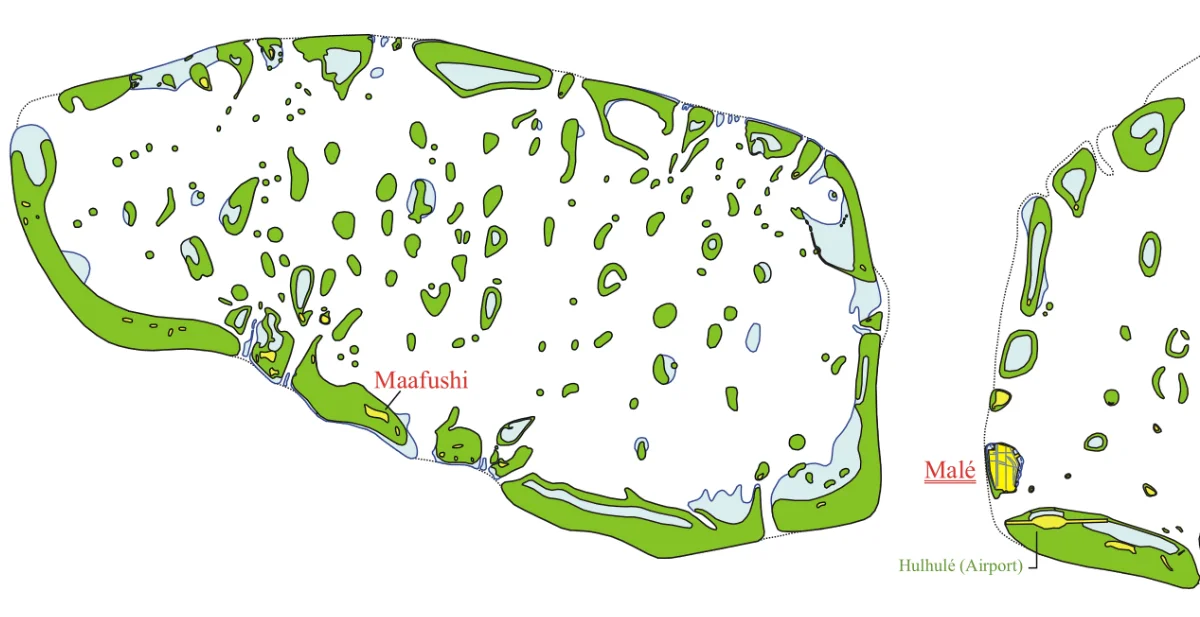
Villivaru Giri
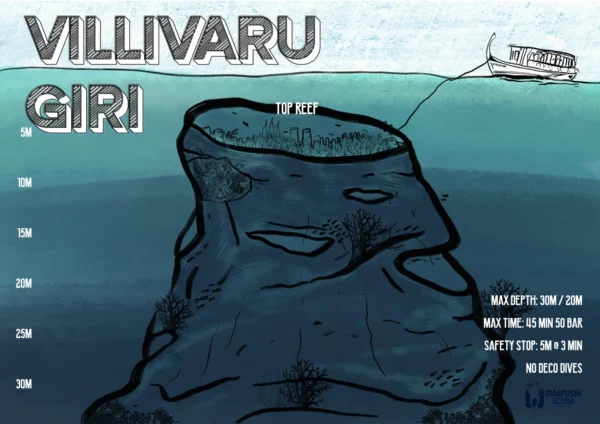
Villivaru Giri is a captivating dive site located near Maafushi in the South Malé Atoll. This submerged pinnacle, or ‘giri,’ offers divers an opportunity to explore vibrant coral formations and encounter a diverse array of marine life.
The reef’s top starts at around 5 meters, descending to depths of up to 30 meters. Divers can expect to see schools of blue-striped snappers, fusiliers, and butterflyfish. The site is also frequented by hawksbill turtles, moray eels, and occasionally, white-tip reef sharks. The numerous overhangs and crevices provide shelter for smaller creatures like nudibranchs and flatworms, making it a haven for macro photography enthusiasts.
Due to the medium to strong currents, Villivaru Giri is suitable for divers with some experience. The currents bring nutrient-rich waters, supporting the abundant marine life and healthy coral growth. Visibility typically ranges between 15 to 30 meters, offering clear views of the underwater scenery.
Night dives at Villivaru Giri reveal a different aspect of the reef, with coral polyps extending to feed and nocturnal species emerging. This site is a favorite among divers seeking both vibrant marine life and the thrill of exploring underwater topography.
Kandooma Caves
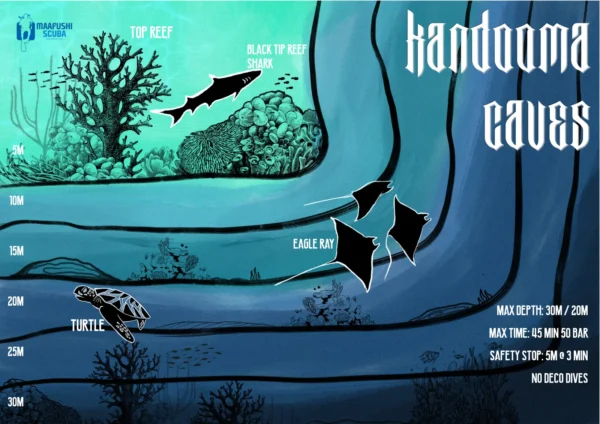
These huge caverns are among the largest and the nicest of all the Maldives’ tourists’ atolls. Two big caves close to one another are just 50m from the corner, one at 20m, the other one at 16m, and the latest one is 70m long and has a curly overhang. Inside the pass, there is a cave at about 10m with a hole going all the way to the top reef at 5m. Inside the caves, we will see yellow sponges, seafans, blue soft coral, small tube corals and often giant morays, as well as squirrelfish, and many groupers. Along the reef we should see clown triggerfish, napoleon, sweetlips, and angelfish, and this is a great site to spot many turtles, especially green turtles.
Lhosfushi Corner
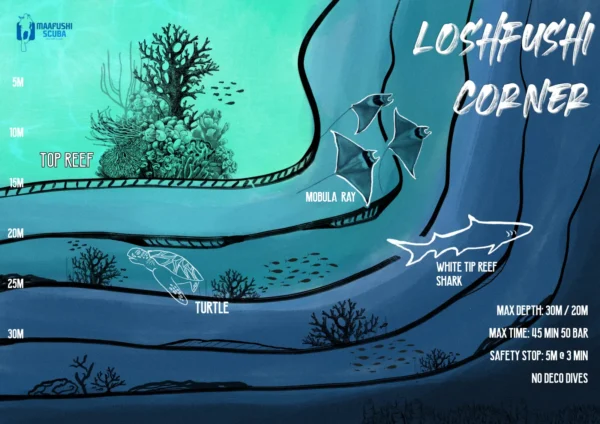
Little channel on the North side of Guraidhoo channel. This channel has a very shallow, narrow sandy canyon, separating the inside from the outside. The channel deepens inside to a sandy bottom at 25m, and the reef slopes from 6m to 30m on the outside. There is plenty of fish life inside the channel and especially inside the canyon. School of sweetlips, snapper, fusiliers, butterflies are very common.
At the entrance of the canyon, with an in coming current, turtles and white tips reef sharks are very often spotted as well as napoleon. The canyon is the high light due to the quantity and diversity of fish and also to the reflection of the light on the sandy bottom.
Bathi Giri
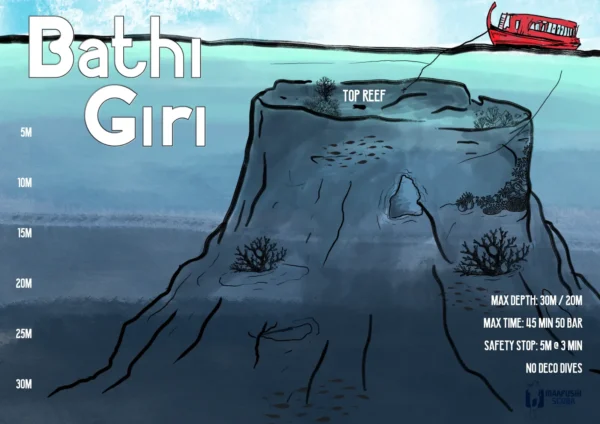
The pinnacle rises up from the 30m deep sandy bottom, touches nearly the surface and is worth to encircle complete when you work your way up to the top. Very pretty overhangs with fondy black corals. Their fine branches with white skin and small polyps, forming large bushy colonies, inhabit the giant winged pearl oyster and black coral shrimps. Take your time to cover the whole area slowly to distinguish a rock from a stone fish, algae from leaf fish and soft corals from a scorpion fish. Please don’t let the schools of fusiliers, jackfish, unicorns and snappers distract you from the amazing macro life at this reef. Excellent spot for night diving, branded snake eels, mantis shrimps, octopus and hermit crabs come out for dinner and the orange crumble and yellow sponges decorate the wall full of compacted clumps of Faulkner’s corals with extended pink and bright orange polyps. Sleeping parrot fishes and turtles wishes not to be disturbed by the torch lights!
Medhu Faru
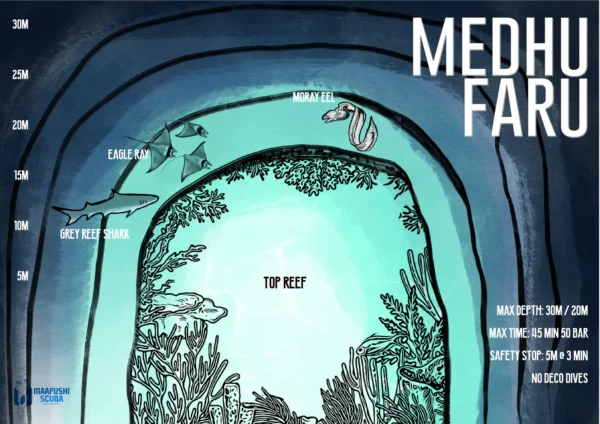
The south side of Medhu Faru has many impressive features making it one of the most scenic drift dives. With an ingoing current, divers can start on the outside reef where a long ledge at 30 meters sweeps round the corner into Guraidhoo Kandu. With wavering sea fans springing out from the ledge, soft coral in abundance and big fish – Sharks, barracuda and napoleon- in open ocean, this is sensational start to exhilarating dive. In outgoing current, Mantas often seen here. Near the corner, the wall of the channel becomes more steeps and current accelerates through the pass. A large rock draped in soft coral lies near the corner forming a small canyon at 18 meters. Sharks, Trevally, Tuna and fusilier congregate here. At 10 to 15 meters there are caves and ledge well worth a visit. One big overhang cuts through the reef from 3 to 30 meters. A sand bay 250 meters inside the channel completes the picture.
Manta Block

Small block of coral at 16 metres depth plenty of small critters. In season it’s a “cleaning station” for the Manta rays.
Miyaru Faru
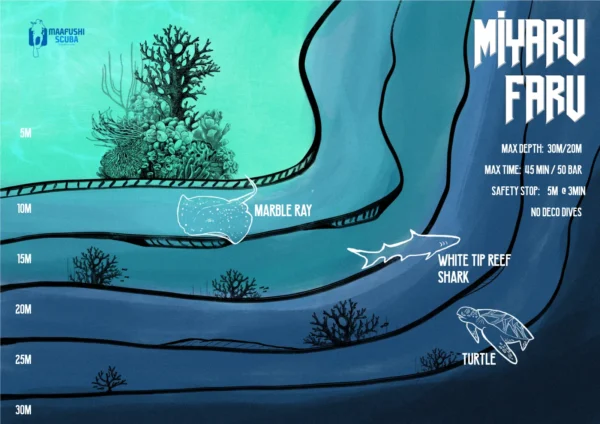
Nice terrace at 26m depth. With in-going current, easy to see white tip sharks, eagle rays, stingrays and Napoleon.
Cocoa Corner
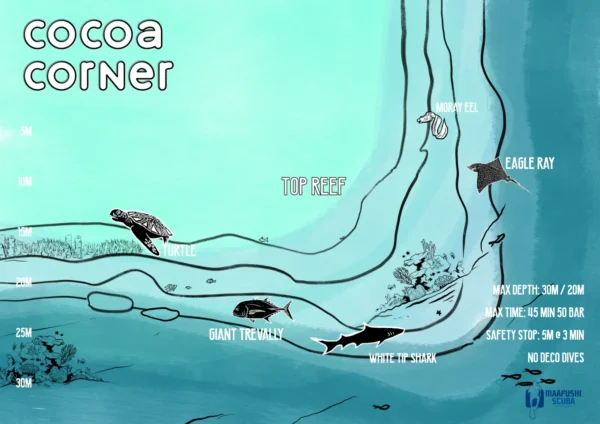
Reef located on the north side of the Kandooma channel. The wall of the channel is steep and we can find many caves and overhangs, whereas the outside reef slopes more gently. Inside the channel 200m from the corner, is a large outcrop of reef 20m long at the depth of 30m. The outside corner offers a great diversity of fish life. School of sweetlips, turtles, snappers, fusiliers and groupers are often seen. We can even spot on the corner at 30m some white tips reef sharks, eagle rays, grey reef sharks. There is also a great quantity of colourful soft coral after the corner in-between 10 and 20m. Some beautiful caves and overhangs at the end of the dive with an in coming current or at the start with an out-going.
Maafushi caves
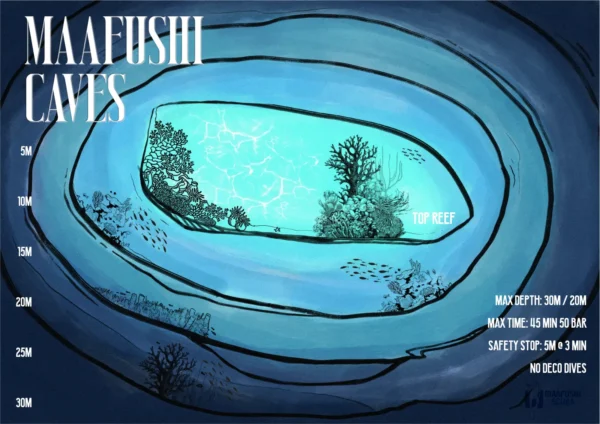
There is a spectacular cave on the north side of a small reef between Maafushi and Dhighufinolhu. It’s opening is on the top reef at five meters and cave drops through the reef to 22m meters. This big overhang named Maafushi Caves invites you to stay and take your time to watch the huge variety of reef life. Eagle rays, White tip shark, Napoleon, Green Sea turtles, Nurse Shark often seen here, and it is a top spot for photographers who don’t want to miss morays with cleaner shrimps, nudibranchs, hawk fish and the colorful covered overhangs.
Triton Giri
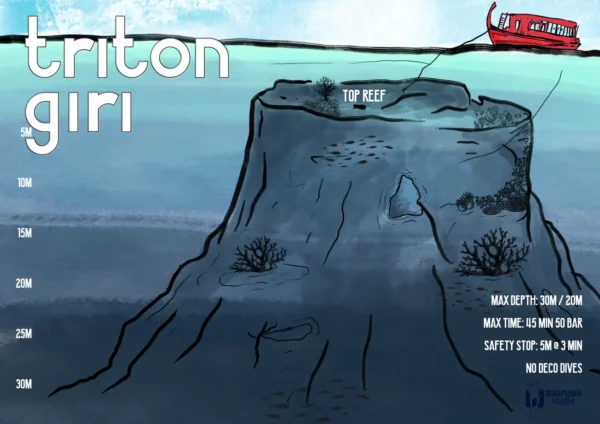
Triton Giri On the inner slope, coral growth maybe rich if the slop is not to steep. Rising from the bottom are separate reefs and coral patches, known as giris and thilas, the giris reach almost the surface, whereas the thilas lie below at a depth with the top of the reef between 5 and 15 meters. Triton giri is siuated more inside the Atoll and has at 15 meters of depth, overhangs with fine meshed seafans, magenta menella, stripedpolyps and white acabaria sea fans, hosting a diversity of shrimps, crabs and flat worms. On the reef giant spaghetti worms live in parchment tubes integrated with sand and shell grith, their sticky tentacles extended to entrap small organisms and detritus. The mantis shrimp and long nose hawk fish are the high light for photographers as well as the gobies, lizard fishes, jaw fish and small lobsters. Naturally the usual reef fish like the fusiliers, jack fish, groupers and parrot fishes are present.
Shark Point
This dive site is renowned for its exhilarating encounters with a diverse array of shark species, including tiger, bull, hammerhead, spinner, guitar, and lemon sharks. Divers can also expect to see over 100 stingrays, adding to the richness of marine life.
Guraidhoo Corner
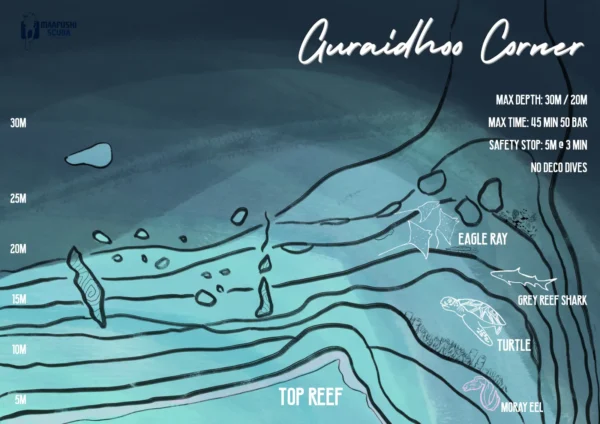
Often considered among the most impressive locations for fish life and photography, not only at South Male Atoll but in the entire Maldives. Guraidhoo Kandu is one that is topographically complex, consisting chiefly on 2 channels and a central reef. It also covers a large area and is really a spot that can be dived several times in different ways and is sometimes subdivided into several individual sites.
The southern channel (often considered a dive site in its own right) is a stretch that runs for around 300 meters and is flanked on each side by vertical walls, past which you will drift effortlessly in the prevailing current. Where the southern channels meet the abyssal drop at around 35 meters, there is often a lot of action such as jacks, Napoleon wrasse and grey reef sharks.
The reef wall provides plenty of current-free indentations where you can take 5 and check out the resident marine creatures, including honeycomb moray eels and long-jawed squirrel fish. There are an impressive number of soft corals, sea fans, black coral bushes and other sessile colour, particularly inside the channel where at 30 meters there is an archway covered on soft corals – a real Kodak moment in the right light.
Dhigu Thila
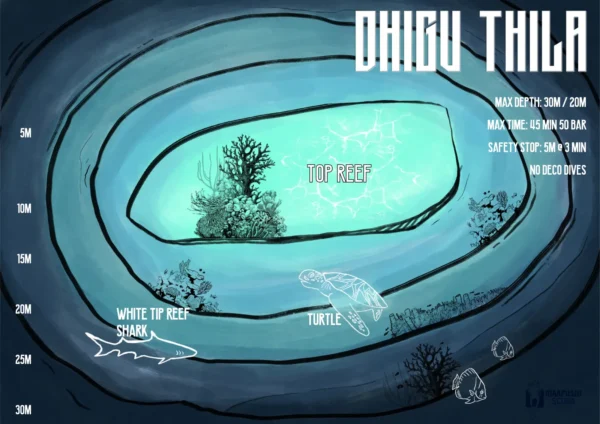
Very long thila (Pinnacle) with magnificent soft corals, plenty of overhangs. White-tip shark, Nurse Shark, Zebra shark, turtles, group of barracudas, Eagle rays, and in season Mantas possible to see on the dive site.
Kandooma Thila
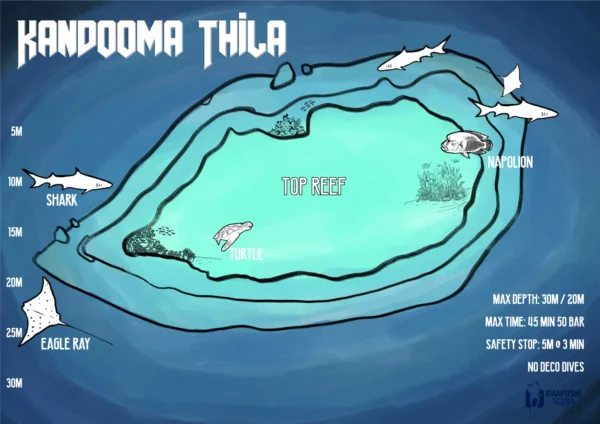
Shaped like a teardrop between 16 and 30m deep. About 250m long – one of the most spectacular dives of this atoll, for scenery as well as prolific fish life. West and north coast are covered with soft corals and schools of red bass or even big-eye trevallies. Top reef is about 20m. There are some outcrops and overhangs where the soft coral outgrowth is very good, but the nicest feature there is the nearly sure meeting with grey sharks, white tip sharks, napoleon and eagle rays that should be found on the north east of the reef, along with tuna and barracuda. To finish in style on the top reef where the hard coral is still intact, green turtles and maybe a school of batfish might accompany us.
Kuda Giri Shipwreck
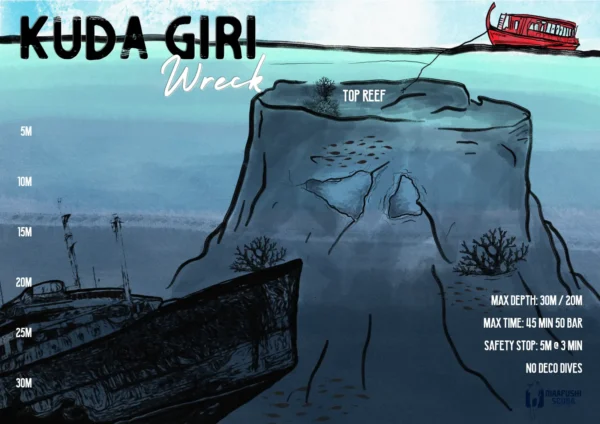
To most people this is a wreck dive since the site is dominated by the small wreck that lies upright on the South Male seabed between 30 and 18 meters depth. However the name of the site described the giri, or pinnacle, that is found nearby and this too could be considered a dive in its own right.
You will probably drop to the deepest part of this wreck to begin your dive. However, the currents are often absent or negligible so this is one site the less experienced diver can enjoy. They may wish to stay toward the shallower bow section. The wreck was sunk on purpose to form an artificial reef and has been well and truly colonized by orange, red and yellow sponges, as well as tubastrea cup coral.
When you are scuba diving on the wreck you should look out for the big schools of glassfish that hover together en masse in the interior, little gobies peeking out from various holes, and a large school of batfish that seems to stay around the wreck. Turtles, humphead wrasse and other large reef predators will also put in frequent appearances. The wreck is penetrable in via a couple of different methods, but is small and any group penetration needs to be handled in an orderly fashion.
Outside the wreck the sandy bottom features garden eels, and shrimp and goby partnerships. You can spot leaf-fish in the broken staghorn, and there are plenty of nudibranchs and flatworms in and around the pinnacle. Fissures in the reef also act as home to octopus, moray eels and thin-armed shrimp. Divers can look out for anemones with their resident anemonefish swimming in and out of the stinging fingers.
As with many sites in the Maldives there are countless red-toothed trigger fish fluttering away from the reef only to dart into their protective holes in the reef at the first sign of danger. If you’re in luck, you might spot an elusive resting guitar shark here too.